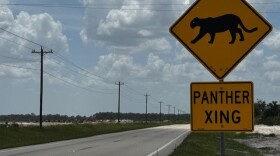
Gov. Rick Scott's nearly half-billion dollars in budget vetoes this week included $2 million for the Underline, a park and bike and walking path planned for the space under the Metrorail tracks from Dadeland to Brickell.
That’s not deterring advocates of the park, though.
Nearly 200 people turned out last night to weigh in on preliminary designs for the park at a community meeting in Coconut Grove.
Sheila Womble, a Miami native and resident of Shenandoah, said of the designs, “I thought they were elegant, I thought they were smart, and I thought they were responsive to the community.”
Lisa Switkin, a principal at James Corner Field Operations, the firm hired to design the Underline, said that the plans intentionally reflected priorities identified by community members earlier on in the process.
“There was a big consensus about safety and intersections and crossings,” she said.
Designers added dedicated bicycle and walking paths and improvements to traffic and rail intersections along the 10-mile stretch.
The plan also includes several options for incorporating native vegetation in the park.
“In other places we have to do so many bells and whistles to get something to grow,” said Switkin, who also designed the Highline, a park along a stretch of abandoned railroad tracks above Manhattan’s West Side. “That’s not the case here.”
She said the Underline offered a great opportunity to showcase the vegetation of native habitats like pine rocklands, hardwood hammocks, and the oolite ridge made of limestone.
Switkin and her colleagues also identified some constraints in building the Underline: it requires cooperation among the many municipalities that the park will cross, MetroRail and Miami-Dade Transit have to conduct ongoing maintenance and inspections operations, and Florida Power and Light is currently seeking approval to construct cement power poles along that same stretch.
And, of course, there’s the issue of funding.
“I think everybody has that question on their mind,” said Jorge Quadreny, a Coral Gables resident who attended the meeting. “I don’t think it’s clear right now.”
With the $2 million in state money off the table, Friends of the Underline, the nonprofit supporting the park, is gearing up to raise funds from other sources.
“We’re very disappointed, but we knew that this appropriation was always subject to a veto,” said Meg Daly, founder and president of Friends of the Underline. “Fortunately, we’re looking at this funding in a layered fashion, so we’re not putting all of our eggs into one basket.”
Rather than waiting for one major funder, Daly said, the group plans to engage several smaller funders to deliver initial proofs of performance and convince other funders to invest in the larger project.
Victor Dover, an urban designer and board member of Friends of the Ludlam Trail, another unused tract of land that community activists are hoping to convert into a multi-use park that connects to the Underline, said he believes communities are excited about these parks and are willing to support them financially.
“The beautiful thing about these linear parks and bike ways is that they’re not just transportation solutions. They’re also park space, they’re works of art, they’re habitat restoration, they’re public space for sharing…they just get a lot of things done with one investment,” he said.
Friends of the Underline will hold another meeting to solicit public feedback at Temple Judea in Coral Gables on Thursday at 6pm. The group plans to unveil final designs for the park in September.
Copyright 2020 WLRN 91.3 FM. To see more, visit WLRN 91.3 FM. 9(MDAyMTYyMTU5MDEyOTc4NzE4ODNmYWEwYQ004))







